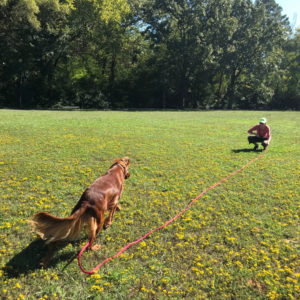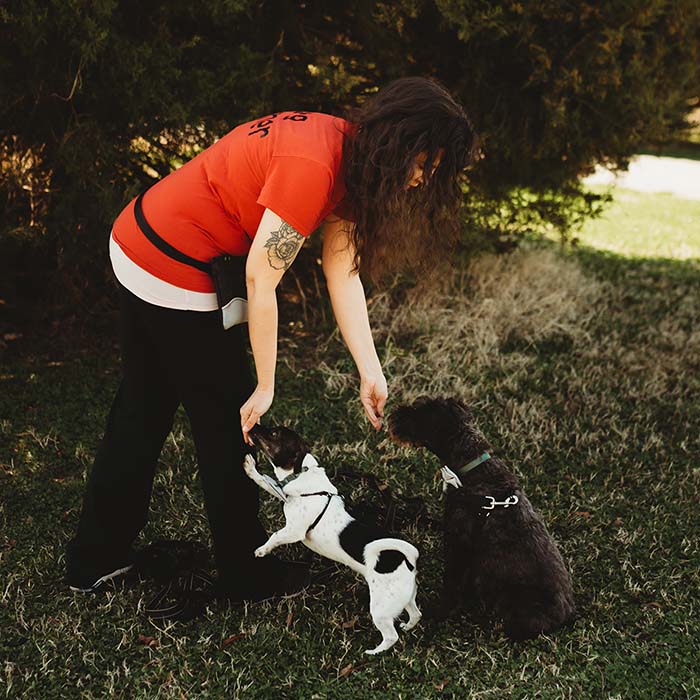The Cues that Save Lives
Damelle Morgan Sr., a Karen Pryor Academy Certified Training Partner and owner and dog trainer at Tip Top Breedz Dog Training, doesn’t care so much if a puppy learns “sit” right away.
He’d rather start with “come”. “The first thing I like to start working on with them is recalls, because recalls save lives,” Damelle explained. “And I feel like if the dog isn’t sitting, I don’t care about the dog sitting. As long as the recall is strong, we’re good, because I need that puppy to come in case it gets away from me.”
Damelle got his first dog when he was 13, against his mother’s wishes. But she fell in love, too, and he got to keep the dog. He realized he wanted a career working with animals. He started working in a kennel, then became the kennel manager. After that, he became a vet tech.
He decided to become a dog trainer after seeing a commercial. “I was on vacation at the beach with my family one day, and a commercial came on the TV,” Damelle shared. “I think it was ABC Dog Training. And I looked at it and I looked at my wife, and I said, ‘That’s exactly what I want to do.’ And then I came back home off of vacation, and within that week, I started looking at different dog training programs. I ended up going with Karen Pryor Academy. Somebody gave them good reviews and told me that, ‘It’s expensive, but it’s worth it.’ And they were right.”
Karen Pryor Academy focuses on clicker training, which was Damelle’s first experience with using the training tool. “I had no idea what I was getting into,” Damelle said. “All I knew is that it was clicker training and I remember being in the pet store, seeing clickers, and I’m like, ‘How is this going to train a dog? Like, really?’ And then I took the foundations course, and then it kind of opened my eyes up on how to do it and how it works. Then, it was like, ‘Okay.’ So then at this time, I had a little Boston Terrier French bulldog mix and he was maybe eight weeks. And I got a clicker and started my foundation course and started clicking and treating him and started to see how it worked, and I was like, ‘Oh, this is great.’”
Based in Frederick, Maryland, Damelle started his dog training company in 2014.
He prefers to focus on puppies. “I like getting them when they’re sponges before they even had a chance to go through the bad things in life,” Damelle said. “So I kind of like to stick to the to the obedience thing. And sometimes I do tricks. I like to keep it basic. Loose leash walking. Good recalls. And things like that. I like that if I get them off on the right foot with their puppy, then it’ll be easier from there. Lay the foundation with them as a puppy and just keep it going from there because then that way they kind of figure out what makes them work.”
After recall, Damelle works on “leave it” and “drop it,” with clients, and he stresses the importance of practicing. “I’m just like, ‘You have to practice with them,’” Damelle shared. “I always have to tell them, ‘Just like athletes. They practice every day. Life is life. And you may not have time every day, but you have at least 30 seconds in a day, where even if all you get is 30 seconds, I mean, it’s better than nothing.’”
After that, it’s time for a “place” cue and crate training. “Once they kind of get good with that, inbetween that stuff, we’ll still work on things like sit,” Damelle said. “But I always tell owners, those are things that we can work on together. Like I’ll lay the foundation, but they practice it too while I’m away, and I always let them know that if it’s more than one person in the household working with the dog, then they should work on separate things with the dog, so then that way they don’t get confused and then they can make the behavior stronger, and then they can pass the cues around.”
He’s realized that different people in the family may teach cues differently. “We may have the same words coming out of our mouth, but we may be standing differently, and that may throw them off,” Damelle said. “Like, ‘I mean, I hear the word but you’re not standing the way that this person was standing so I really don’t know what you’re doing.’ The one person who teaches it gets it real strong, put it on cue and then go ahead and try to pass it around. But I feel like sometimes a lot of people try to rush it. I’m like, ‘Don’t rush it unless you feel like that’s exactly what they’re going to do when they come to you.’”
Damelle has two dogs of his own: Reign and Warrior. “Puppies are hard,” he shared. “I always tell myself, I love puppies as long as they go home with someone else. My dogs are one and two, so I feel like I’m kind of over the puppy thing. I tell them, you have to be on their schedule in the beginning, then you kind of rotate them to your schedule, but you do it slowly and make sure that it’s comfortable for them and take baby steps and don’t try to rush things. … I still tell them too, ‘You still have to have rules for them too, but it’s just you have to teach it to them. They don’t come to you programmed already.’”
And it’s important to teach kids and dogs to respect one another, which is something Damelle has worked through with his own five children. “I always tell my kids, ‘You have to respect them.’” Damelle shared. “‘They have to respect you, too, but you have to respect them as well, because if you do things to them then that can upset them and you don’t want to upset them.’ All of my kids that’s old enough, they usually work with the dogs too, so they have that relationship with them. I feel like they’ll be fine and I never leave them alone anyway. Like if I’m gonna go somewhere, I’ll put the dogs up if the kids don’t go with me. I’ll put them up, but other than that the dogs do whatever they want to do and the kids do what they want to do and they interact when they want to. It’s all about giving them options.”
And allowing them to use their voice to communicate. “I tell them if you punish that growl, it’s gonna go away, and they’re just gonna attack,” Damelle explained. “And they’re like, ‘But I don’t want him growling.’ I say, ‘Okay, so figure out what in the environment has your dog growling, and see if you can get away from it. And then, on another day, slowly break it down.’ Which is you and your dog and whatever the situation was, see if you can kind of reenact it a little bit so that you can work them up to not be so nervous about it. Let them realize that is good in things that they see or look at or that they used to be afraid of because it’s not always necessarily a mean growl. It can be an uncomfortable growl.”
Plus, having a safe place for puppies or dogs to go when they need some space is helpful. “I always recommend to clients to have crates for their dog because that can be their safe place,” Damelle said. “If they don’t want to be bothered with the kids, then they can just go in their place or go to their bed or their mat or whatever you have out for them to go to. And you just let the kids know when they’re there, off limits. When you see them go to that spot, don’t mess with them. That’s their time.”
Start With These Cues
- Recall (“Come”)
- Leave It
- Drop It
- Place or Crate Training
Hear more of Damelle’s story on the podcast or on your favorite podcast platform under Telltail Dog. Find his episode’s transcript here. You can email him at dogtrainer86@icloud.com or find him on Instagram and Facebook at Tip Top Breedz Dog Training.




